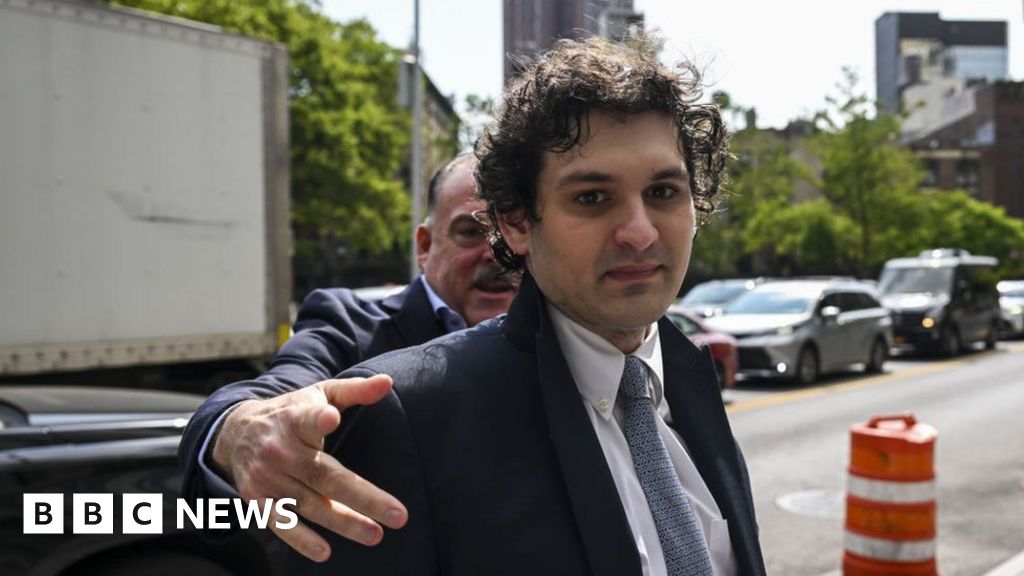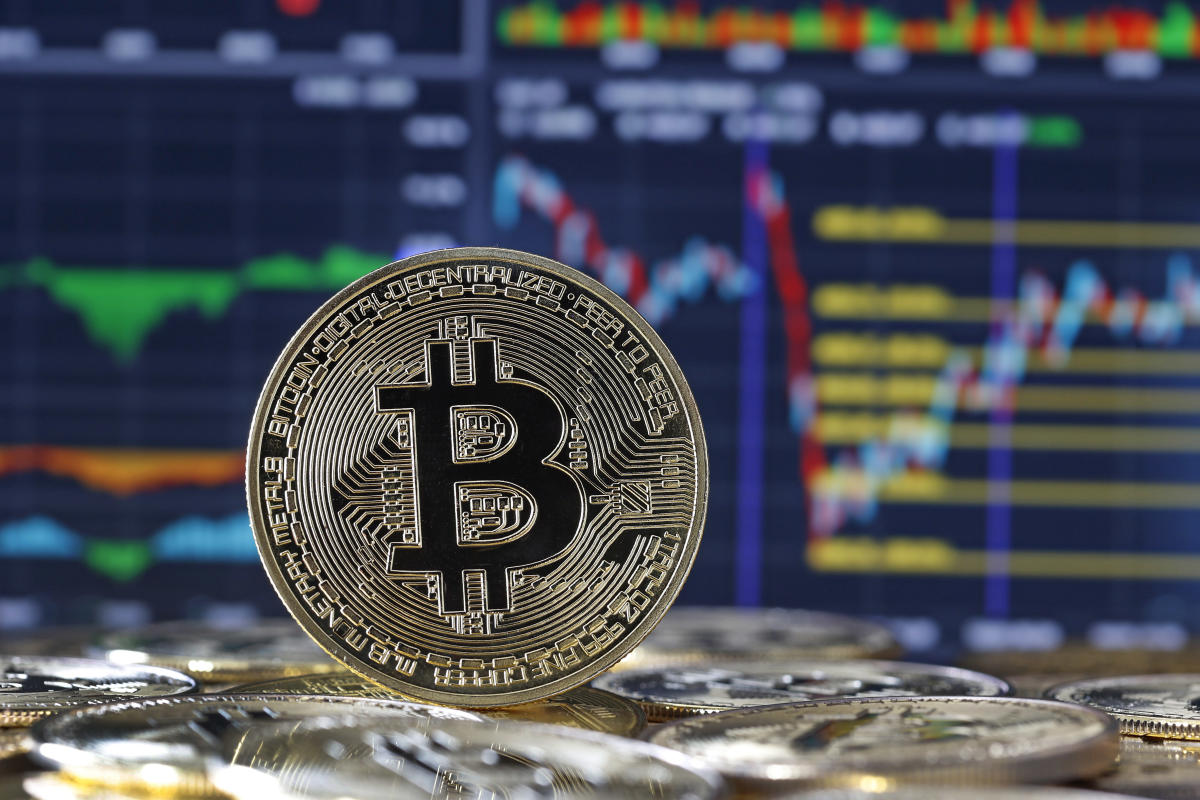News
Everyone got duped by Sam Bankman-Fried’s big gamble

- By Holly Honderich, Natalie Sherman & Erin Delmore
- BBC News
3 November 2023
Updated 28 March 2024
Image source, Getty Images
Sam Bankman-Fried has been sentenced to 25 years for stealing billions of dollars from customers of his cryptocurrency exchange FTX. It’s a spectacular downfall for Silicon Valley’s dishevelled wunderkind, who rubbed elbows with celebrities like Gisele Bündchen and Tom Brady.
On 7 November 2022, as his empire began its dizzying, irrevocable collapse, Bankman-Fried did what he always did: he weighed the odds.
Earlier that day, a rival executive had expressed concerns on social media about the finances of Bankman-Fried’s crypto exchange, spooking customers into a multi-billion dollar bank run.
In an online chat, Bankman-Fried consulted two of his top deputies. “To be clear you think the tweet is net bad?” he asked them.
They considered their options. Was it possible that his rival would walk back the criticism? Was it probable that that would stem the bleeding? “Fairly unlikely,” Bankman-Fried wrote.
It was the kind of calculus Bankman-Fried had been making for years, the quick equations friends said he used in nearly every situation – mulling a break-up, assessing a risky trade.
To play this content, please enable JavaScript, or try a different browser
Video caption, Watch: What happens to crypto after Sam Bankman-Fried?
For a while, that approach seemed to work. As the boy-wonder of crypto, Bankman-Fried got rich faster than almost anyone in history, amassing an estimated $26bn in personal wealth, countless magazine covers and sweeping political influence. The flameout was even faster.
The tweet was, as discussed, net bad. Billions gushed out of the platform in less than five days. When it was all over, more than $8bn in customer funds were missing and the company was bankrupt. Five weeks after that, prosecutors in Manhattan charged Bankman-Fried, who had already resigned, with several financial offences including wire fraud, securities fraud, commodities fraud and money laundering.
Over four weeks of trial, two contradictory stories emerged. In one, the former mogul was a brilliant but hapless savant, whose mistakes as CEO allowed for massive fraud to be carried out under his nose. In the other, supported by former members of his inner circle, Bankman-Fried syphoned billions of dollars of customer money, banking on the odds he’d never be caught.
Both tellings reveal how tightly the fortunes of FTX were tied to the image of its founder, whose oddball magnetism drew former presidents, celebrities, and corporate titans into his orbit and his multi-billion dollar gamble.
Image caption, “Mostly I sleep on a beanbag,” Mr Bankman-Fried once told his Twitter followers
Bankman-Fried wasn’t shy about it: he wanted to get rich. But, to hear him tell it, he wanted to make all those billions just to give them away.
An overachieving child born to two overachieving parents, Bankman-Fried and his younger brother were taught at an early age about utilitarianism, a doctrine holding that the most ethical choice is the one that does the most good for the most people.
As a student at MIT, Bankman-Fried went to a talk by Will MacAskill, a 25-year-old doctoral student at Oxford and founder of effective altruism, a utilitarian-tinged philosophy that uses maths to figure out how individuals can maximise their philanthropic impact.
To do the most good, Mr MacAskill told him, Bankman-Fried could take his considerable intellect to lucrative Wall Street, and donate most of his salary to important causes.
Bankman-Fried was sold. In 2014, he took his degree straight to Jane Street, a high-frequency trading firm, and reportedly gave away about half of his income to worthy causes.
Three years later, Bankman-Fried found an industry that could make him even richer than typical trading: crypto.
At the age of 25, he founded Alameda Research, a crypto investment firm, after noticing that prices of Bitcoin varied considerably in different countries. The arbitrage trading earned Alameda a reported $20m in just three weeks.
In 2019, he founded FTX, then a Hong Kong-based crypto exchange for international investors. Like Elizabeth Holmes – another Silicon Valley billionaire whose star came crashing down – he was able to convince big name investors to lend the company not only cash, but credibility.
Within months, daily trading volume on FTX had reached $300m. By 2021, he had debuted on the Forbes 400, the magazine’s annual list of the richest Americans, with a fortune of $22.5bn.
Some have attributed his remarkable success to an unusually high tolerance for risk, a willingness to chance devastating consequences for a big reward.
“He would be happy to flip a coin, if it came up tails and the world was destroyed,” his ex-girlfriend and former CEO of Alameda Research Caroline Ellison said at trial. “As long as if it came up heads the world would be more than twice as good.”
Image caption, Bankman Fried once appeared on stage at a conference with former UK leader Tony Blair and former US President Bill Clinton
Image source, Shutterstock
Image caption, And with supermodel Gisele Bündchen, right, and the pair appeared in an ad in Vogue together for his company FTX
According to internal accounts, life at FTX could sometimes resemble a grown-up maths camp, filled with a selection of brilliant misfits and led by the perpetually rumpled Bankman-Fried.
“He was super disorganised, he was always in cargo shorts, he was always sloppy,” a former FTX employee told the BBC. “He would walk around the office in bare feet.”
Those at the top were a tight-knit group who sometimes blindly listened to Sam, the employee said. “It could be cult-like.”
Natalie Tien, who handled public relations and Bankman-Fried’s schedule at FTX for more than two years, said he was charismatic to the point that the company sometimes felt “toxic”.
“We just trusted him 100%,” she told the BBC. “To a degree that we kind of worried [about] speaking up for ourselves.”
It wasn’t only people inside the company that were enthralled.
Appearing side-by-side with Bill Clinton, Tony Blair, Gisele Bundchen and Katy Perry in shorts and ill-fitting T-shirts, he became an ambassador of sorts for the crypto industry as whole, just as it began to reach new heights.
Part of the mystique was that Bankman-Fried seemed to eschew the level of luxury his earnings could have afforded. He didn’t own a yacht, his defence attorneys said at trial. He drove a beat-up Toyota Corolla. Meanwhile, he testified before Congress arguing for more regulation of the crypto market, setting him apart from many of his peers.
“In a weird way, he seemed kind of like the grown-up in the crypto world,” said Zeke Faux, an investigative journalist and author of Number Go Up: Inside Crypto’s Wild Rise and Staggering Fall.
And, of course, there was his stated ultimate objective: Bankman-Fried was going to give it all away.
“It was a great story, everybody loved it,” said Mr Faux. “People loved it in Congress, the VCs loved it, the bankers loved it.”
“The problem with his story is that it was not true,” he said.
In September of 2022, the venture capital firm Sequoia Capital ran a breathless profile of Bankman-Fried in its magazine. At the time, FTX was valued at $32bn.
In the since-deleted piece entitled FTX’s SBF Has a Savior Complex, and Maybe You Should Too, author Adam Fisher described Bankman-Fried’s efforts to maximise his wealth in order to maximise his impact on the world. It involved a risk, Fisher wrote. “But the math couldn’t be clearer.”
“To do the most good for the world,” he said, “SBF needed to find a path on which he’d be a coin toss away from going totally bust.”
A month-and-a-half later, industry news site CoinDesk published a bombshell report alleging that Alameda had over half its $15bn portfolio in FTT – the crypto token printed by FTX. The disclosure raised questions about the actual value of Alameda’s holdings, and the apparent conflict of interest between Alameda and FTX – ostensibly independent companies.
Then came that announcement on 6 November from industry rival, Binance CEO Changpeng Zhao, known as CZ, who said he would dump his own sizable stores of FTT.
On 11 November, the implosion of FTX was complete, the story of crypto’s prodigy gone with it.
For some observers of the crypto boom, and Bankman-Fried’s meteoric rise to power, the fall was not unexpected.
Image caption, In a now deleted post Sequoia Capital said Sam Bankman-Fried’s ‘intellect is as awesome as it is intimidating’.
As FTX rose to prominence, the actor Ben McKenzie, best known for his role on the television show the OC, emerged as one of the country’s most vocal crypto sceptics.
In July 2022, Bankman-Fried agreed to sit down for an interview with Mr McKenzie for a book the actor was writing, titled Easy Money: Cryptocurrency, Casino Capitalism, and the Golden Age of Fraud.
In a cramped Manhattan hotel room, in an encounter that Mr McKenzie described as “probably the strangest hour of my life”, Bankman-Fried tried to pitch the actor on crypto – and Sam Bankman-Fried – as a force for good in the world.
“I think he marketed himself to me as a version of his public persona, which at the time was the California wunderkind, billionaire philanthropist,” Mr McKenzie said.
It was an image that even Mr McKenzie had bought into, to an extent, he said. Until they began talking, that is. “He had trouble just giving me straight answers to basic questions, one of which was, what does crypto currency do?” the actor said.
Over four weeks of trial in Manhattan, Bankman-Fried’s attorneys painted their client as a math nerd who was overwhelmed by his expanding empire.
On the stand, now in a suit, with his hair cut short, Bankman-Fried directed some of the blame at Ms Ellison, who had pleaded guilty to fraud, for failing to “hedge” bets to better protect Alameda from a downturn in the market, as he had instructed her to do.
The prosecution, in turn, painted Bankman-Fried as someone whose boundless aspiration went hand-in-hand with a hubris that led Bankman-Fried to play the odds with his company.
“The defendant was gambling with customer money,” prosecutor Nicolas Roos argued.
Bankman-Fried’s courtroom downfall was aided by former members of his inner circle, including Ms Ellison, who acted as chief executive of Alameda, as well as college roommates Adam Yedida and Gary Wang, and Nishad Singh, a childhood friend of Bankman-Fried’s younger brother.
Image source, Getty Images
Image caption, His ex-girlfriend, Caroline Ellison, was a key witness for the prosecution
They testified that while promising to safeguard customer funds and clean up the industry, Bankman-Fried was directing them to commit fraud, opening up a back door between Alameda and FTX so he could use FTX as a personal piggybank. The money fuelled his rise, as he splashed out on property, billions in investments and some $100m in political donations – not to mention helping to cover billions in debts owed by Alameda.
His physical appearance, too, was contrived, Ms Ellison testified – his messy hair and cheap car deemed “better for his image”, because it made him look more authentic than a typical trader. But that down-to-earth image belied his intense ambition, she said.
“He thought there was a 5% chance he would become president someday,” Ms Ellison said at trial. “Of the United States.”
While many have watched the trial as a sort of comeuppance, former FTX employee Natalie Tien has looked to it for closure, and is one of the few former employees to attend the trial regularly.
On the one hand, it was a relief to realise that her own doubts and questions about some things – like extravagant spending on celebrity sponsorships – had been justified. The last time she communicated with her former boss, in December 2022, he had just been released on bail and sent her a music video of Eminem, rapping “Without Me” to celebrate.
But the 33-year-old also felt some parts of the story – especially around his schedule and his use of private jets – were being taken “out of context”.
“He did lie and he took the money, yes, but I don’t think it’s because he was greedy,” she said. “Because I actually saw him every day wearing crappy old T-shirts with no shoes and driving a shitty car.”
“It was not an act,” she said.
Bankman-Fried now faces up to 110 years in prison, and an indelible reputation as one of the greatest fraudsters in US history. Lawyers working on the bankruptcy case have said they have recovered more than $7bn in missing money.
“I think it says more about us than it does about him,” Mr McKenzie said.
“He got so far, I think, in many ways because of his lineage, because he is the son of Stanford professors, because he did go to MIT, because he worked on Wall Street. The myth of Sam Bankman-Fried grew in relation to the myth of crypto itself, right?”
Downfall of a Crypto King
With additional reporting from James Clayton
News
Bitcoin soars above $63,000 as money flows into new US investment products

Bitcoin has surpassed the $63,000 mark for the first time since November 2021. (Chesnot via Getty Images)
Bitcoin has broken above the $63,000 (£49,745) mark for the first time since November 2021, when the digital asset hit its all-time high of over $68,000.
Over the past 24 hours, the value of the largest digital asset by market capitalization has increased by more than 8% to trade at $63,108, at the time of writing.
Learn more: Live Cryptocurrency Prices
The price appreciation was fueled by record inflows into several U.S.-based bitcoin cash exchange-traded funds (ETFs), which were approved in January this year.
A Bitcoin spot ETF is a financial product that investors believe will pave the way for an influx of traditional capital into the cryptocurrency market. Currently, indications are favorable, with fund managers such as BlackRock (BLK) and Franklin Templeton (BEN), after allocating a record $673 million into spot Bitcoin ETFs on Wednesday.
Learn more: Bitcoin’s Success With SEC Fuels Expectations for an Ether Spot ETF
The record allocation surpassed the funds’ first day of launch, when inflows totaled $655 million. BlackRock’s iShares Bitcoin Trust ETF (I BITE) alone attracted a record $612 million yesterday.
Bitcoin Price Prediction
Earlier this week, veteran investor Peter Brandt said that bitcoin could peak at $200,000 by September 2025. “With the push above the upper boundary of the 15-month channel, the target for the current market bull cycle, which is expected to end in August/September 2025, is raised from $120,000 to $200,000,” Brandt said. published on X.
The influx of capital from the traditional financial sphere into Bitcoin spot ETFs is acting as a major price catalyst for the digital asset, but it is not the only one. The consensus among analysts is that the upcoming “bitcoin halving” could continue to drive flows into the bitcoin market.
The Bitcoin halving is an event that occurs roughly every four years and is expected to happen again next April. The halving will reduce the bitcoin reward that miners receive for validating blocks on the blockchain from 6.25 BTC to 3.125 BTC. This could lead to a supply crunch for the digital asset, which could lead to price appreciation.
The story continues
Watch: Bitcoin ETFs set to attract funds from US pension plans, says Standard Chartered analyst | Future Focus
Download the Yahoo Finance app, available for Apple And Android.
News
FRA Strengthens Cryptocurrency Practice with New Director Thomas Hyun

Forensic Risk Alliance (FRA), an independent consultancy specializing in regulatory investigations, compliance and litigation, has welcomed U.S.-based cryptocurrency specialist Thomas Hyun as a director of the firm’s global cryptocurrency investigations and compliance practice. Hyun brings to the firm years of experience building and leading anti-money laundering (AML) compliance programs, including emerging payment technologies in the blockchain and digital asset ecosystem.
Hyun has nearly 15 years of experience as a compliance officer. Prior to joining FRA, he served as Director of AML and Blockchain Strategy at PayPal for four years. He established PayPal’s financial crime policy and control framework for its cryptocurrency-related products, including PayPal’s first consumer-facing cryptocurrency offering on PayPal and Venmo, as well as PayPal’s branded stablecoin.
At PayPal, Hyun oversaw the second-line AML program for the cryptocurrency business. His responsibilities included drafting financial crime policies supporting the cryptocurrency business, establishing governance and escalation processes for high-risk partners, providing credible challenge and oversight of front-line program areas, and reporting to the Board and associated authorized committees on program performance.
Prior to joining PayPal, Hyun served as Chief Compliance Officer and Bank Secrecy Officer (BSA) at Paxos, a global blockchain infrastructure company. At Paxos, he was responsible for implementing the compliance program, including anti-money laundering and sanctions, around the company’s digital asset exchange and its asset-backed tokens and stablecoins. He also supported the company’s regulatory engagement efforts, securing regulatory approvals, supporting regulatory reviews, and ensuring compliance with relevant digital asset requirements and guidelines.
Thomas brings additional experience in payments and financial crime compliance (FCC), having previously served as Vice President of Compliance at Mastercard, where he was responsible for compliance for its consumer products portfolio. He also spent more than seven years in EY’s forensics practice, working on various FCC investigations for U.S. and foreign financial institutions.
Hyun is a Certified Anti-Money Laundering Specialist (CAMS) and a Certified Fraud Examiner (CFE). He is a graduate of New York University’s Stern School of Business, where he earned a bachelor’s degree in finance and accounting. Additionally, he serves on the board of directors for the Central Ohio Association of Certified Anti-Money Laundering Specialists (ACAMS) chapter.
Commenting on his appointment, Hyun said, “With my experience overseeing and implementing effective compliance programs at various levels of maturity and growth, whether in a startup environment or large enterprises, I am excited to help our clients overcome similar obstacles and challenges to improve their financial crime compliance programs. I am excited to join FRA and leverage my experience to help clients navigate the complexities of AML compliance and financial crime prevention in this dynamic space.”
FRA Partner, Roy Pollittadded: “As the FRA’s sponsor partner for our growing Cryptocurrency Investigations and Compliance practice, I am thrilled to have Thomas join our ever-expanding team. The rapid evolution of blockchain and digital asset technologies presents both exciting opportunities and significant compliance challenges. Hiring Thomas in a leadership role underscores our commitment to staying at the forefront of the industry by enhancing our expertise in anti-money laundering and blockchain strategy.”
“Thomas’ extensive background in financial crime compliance and proven track record of building risk-based FCC programs in the blockchain and digital asset space will be invaluable as we continue to provide our clients with the highest level of service and innovative solutions.”
“FRA strengthens cryptocurrency practice with new director Thomas Hyun” was originally created and published by International Accounting Bulletina brand owned by GlobalData.
The information on this website has been included in good faith for general information purposes only. It is not intended to amount to advice on which you should rely, and we make no representations, warranties or assurances, express or implied, as to its accuracy or completeness. You must obtain professional or specialist advice before taking, or refraining from, any action on the basis of the content on our website.
News
Bitcoin trades around $57,000, crypto market drops 6% ahead of Fed decision

-
Bitcoin fell in line with the broader cryptocurrency market, with ether and other altcoins also falling.
-
Financial markets were weighed down by risk-off sentiment ahead of the Fed’s interest rate decision and press conference later in the day.
-
10x Research said it is targeting a price target of $52,000 to $55,000, anticipating further selling pressure.
Bitcoin {{BTC}} was trading around $57,700 during European morning trading on Wednesday after falling to its lowest level since late February, as the world’s largest cryptocurrency recorded its worst month since November 2022.
BTC has fallen about 6.3% over the past 24 hours, after breaking below the $60,000 support level late Tuesday, according to data from CoinDesk. The broader crypto market, as measured by the CoinDesk 20 Index (CD20), lost nearly 9% before recovering part of its decline.
Cryptocurrencies have been hurt by risk-off sentiment in broader financial markets amid stagflation in the United States, following indications of slowing growth and persistent inflation that have dampened hopes of an interest rate cut by the Federal Reserve. The Federal Open Market Committee is due to deliver its latest rate decision later in the day.
Ether {{ETH}} fell about 5%, dropping below $3,000, while dogecoin {{DOGE}} led the decline among other major altcoins with a 9% drop. Solana {{SOL}} and Avalanche {{AVAX}} both lost about 6%.
Bitcoin plunged in April, posting its first monthly loss since August. The 16% drop is the worst since November 2022, when cryptocurrency exchange FTX imploded, but some analysts are warning of further declines in the immediate future.
10x Research, a digital asset research firm, said it sees selling pressure toward the $52,000 level due to outflows from U.S. cash exchange-traded funds, which have totaled $540 million since the Bitcoin halving on April 20. It estimates that the average entry price for U.S. Bitcoin ETF holders is $57,300, so this could prove to be a key support level.
The closer the bitcoin spot price is to this average entry price, the greater the likelihood of a new ETF unwind, 10x CEO Markus Thielen wrote Wednesday.
“There may have been a lot of ‘TradeFi’ tourists in crypto – pushing longs all the way to the halving – that period is now over,” he wrote. “We expect more unwinding as the average Bitcoin ETF buyer will be underwater when Bitcoin trades below $57,300. This will likely push prices down to our target levels and cause a -25% to -29% correction from the $73,000 high – hence our $52,000/$55,000 price target over the past three weeks.”
The story continues
UPDATE (May 1, 8:56 UTC): Price updates throughout the process.
UPDATE (May 1, 9:57 UTC): Price updates throughout the process.
UPDATE (May 1, 11:05 UTC): Adds analysis from 10x.
News
The Cryptocurrency Industry Is Getting Back on Its Feet, for Better or Worse

Hello from Austin, where thousands of crypto enthusiasts braved storms and scorching heat to attend Consensus. The industry’s largest and longest-running conference, which can sometimes feel like a religious revival, offers opportunities to chat and listen to leading names in crypto. And for the casual observer, Consensus offers a useful glimpse into the mood of an industry prone to wild swings in fortune.
Unsurprisingly, the mood is noticeably more positive than it was a year ago, when crowds were sparse and many attendees were quietly confiding that they were considering switching to AI. In practice, that means some of the more obnoxious elements are back, but not to the level of Consensus 2018 in New York, when charlatans parked Lamborghinis outside the event and the hallways were lined with booth girls and scammers pitching “ICOs in a box.”
This time around, Elon Musk’s Cybertrucks have replaced Lamborghinis as the vehicle of choice for marketers. One of the most notable publicity stunts was a startup that paid a poor guy to parade around in the Texas sun in a Jamie Dimon costume, wig, and mask, and then staged a mock assault on him by memecoin characters.
Outside the event was a giant “RFK for President” truck, while campaign staffers manned a booth instead — a reflection of both the election year and crypto’s willingness to latch onto any candidate, no matter how outlandish, who will talk about the industry. RFK himself is scheduled to address the conference on Thursday.
Excesses aside, the general sense of optimism was understandable. The cryptocurrency market has not only recovered from the wave of fraud that nearly sank it in 2022, it is riding a new wave of political legitimacy. This month, cryptocurrencies scored once-unthinkable political victories in Washington, D.C., and there is a sense that the industry has not only withstood the relentless regulatory assaults of SEC Chairman Gary Gensler and Sen. Elizabeth Warren, but is poised to defeat them.
And while cryptocurrency is still searching for its flagship application, the optimists I spoke with pointed to signs that it is (once again) upon us. Those signs include the rapid advancement of zero-knowledge proofs as well as the popularity of Coinbase’s Base blockchain and, perhaps most importantly, the large-scale arrival of traditional finance into the world of cryptocurrencies – a development that not only provides a major financial boost, but also a new element of stability and maturity that will, perhaps, tame the worst of crypto’s wilder side. Finally, this consensus marked the end of the Austin era as the conference, under new leadership, will be held in Toronto and Hong Kong in 2025.
The story continues
Jeff John Roberts
jeff.roberts@fortune.com
@jeffjohnroberts
This story was originally featured on Fortune.com
-

 News12 months ago
News12 months agoBitcoin soars above $63,000 as money flows into new US investment products
-

 DeFi12 months ago
DeFi12 months agoEthena downplays danger of letting traders use USDe to back risky bets – DL News
-

 News12 months ago
News12 months agoFRA Strengthens Cryptocurrency Practice with New Director Thomas Hyun
-

 DeFi12 months ago
DeFi12 months agoZodialtd.com to revolutionize derivatives trading with WEB3 technology
-

 Markets12 months ago
Markets12 months agoBitcoin Fails to Recover from Dovish FOMC Meeting: Why?
-

 DeFi1 year ago
DeFi1 year ago👀 Lido prepares its response to the recovery boom
-

 Markets1 year ago
Markets1 year agoWhale Investments in Bitcoin Reached $100 Billion in 2024, Fueling Crazy Investor Optimism ⋆ ZyCrypto
-

 Markets1 year ago
Markets1 year agoWhy Bitcoin’s price of $100,000 could be closer than ever ⋆ ZyCrypto
-

 DeFi1 year ago
DeFi1 year agoPancakeSwap integrates Zyfi for transparent, gas-free DeFi
-

 Markets1 year ago
Markets1 year agoWhales are targeting these altcoins to make major gains during the bull market 🐋💸
-

 DeFi1 year ago
DeFi1 year ago🏴☠️ Pump.Fun operated by Insider Exploit
-

 News1 year ago
News1 year agoHow to make $1 million with crypto in just 1 year 💸📈





